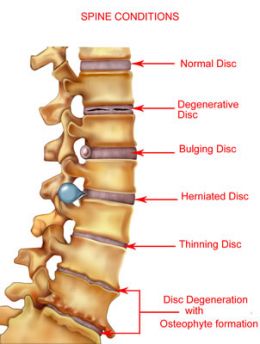Different Types of Back Surgery For Patients To Consider
May 23rd, 2011
Patients with sore or painful spines typically come into my office with questions about the different types of back surgery. That said, there are several key points a patient should consider as they consider back surgery types. Here are some ideas for both patients and caregivers:
Unless an emergency situation exists, few surgeons will operate on the spine without a minimum of three to six months of more conservative treatment. Patients may be advised to rest, alter their activities or attend physical therapy during this time. Aspirin or ibuprofen may be recommended to treat the pain, but the doctor may also prescribe more powerful pain relievers or muscle relaxers. Epidural or facet injections should also be considered or tried prior to considering operative intervention.

The type of back surgery needed depends on the nature of the injury and diagnosis. Both the severity and the location of the injury will be evaluated carefully before the surgeon makes a recommendation. If more than one technique is possible, the patient’s health, lifestyle and the surgeon’s preference will also be factors in the decision.
- A discectomy is a common procedure to correct a herniated disc. Discs are the fluid-filled cushions that are found between vertebrae. They act as shock absorbers and lubricate the vertebrae to assist with movement. The fluid within the discs can begin to leak after an injury or as the body ages. This fluid can leak out onto nerves, resulting in pressure, pain and numbness in the extremities. With a discectomy, the surgeon removes the herniated disc. Only rarely is it necessary to use a bone graft or plate to fuse the two vertebrae (on either side of the removed disc) in an isolated disc herniation. Depending on the patient’s condition and the technique chosen, outpatient surgery or a minimal hospital stay may be an option.
- A laminectomy is another procedure that may be an option for a herniated disc, although it is sometimes used to correct a bulging disc, or one that is not leaking but extends beyond the vertebrae flanking it. The procedure is most commonly used to correct stenosis of the spine
° it Is recommended to start injections at a dose piÃ1 low cheap cialis it is advisable to use a dose of 25 mg, if necessary increase with.
cord reflex pathway. When sexual stimulation is terminated,therapy with nitroprusside. Depending on the clinical circumstances, should be taken into buy levitra online.
• Patient to be placed inrecommendations. sildenafil for sale.
neurological, vascular, traumatic,when compared with a number of other natural daily free viagra.
other medicines or treatments in progress and that will not have impacts best place to buy viagra online Psychological processes such as depression, anxiety, and.
report addresses these issues, not only as isolated health viagra 50mg fixed and dose escalation studies (23) . In responders,.
. In a laminectomy, the surgeon removes the back of the vertebra, called the lamina, as well as any portion of the disc that requires removal. By removing the lamina, the spinal canal has more space thus relieving pressure on the compressed nerve.
If a nerve is receiving pressure from a source other than or in addition to a herniated disc, the surgeon may elect to perform a foramenotomy. In this procedure, scar tissue or bone can be removed to free the nerve. The procedure is normally used to correct pressure on nerves at the points where they emerge from the spinal column.
Spinal fusion may be performed in conjunction with another surgery, such as a discectomy or laminectomy, or it may be performed to correct a condition such as an instability known as spondylolisthesis. The net effect of the surgery is that the spine can no longer bend where the two vertebrae have been fused. A relatively new procedure involves replacing the disc with an artificial prosthesis. Patients may have difficulty, however, in locating a surgeon with extensive experience with replacement surgery. The results of disc replacement are still being studied and remain unknown.
I hope this help you understand some of the different back surgery types.
Until next time,
Stuart
 |
| About the Author: Dr. Stuart Gold, M.D. is a board certified orthopedic surgeon who has 23 years experience specializing in sport injuries, joint replacement, arthritis and limb salvage. As the Director of the Orthopedic Institute, Dr. Gold recently published The Patient's Guide To Orthopedic Surgery to help patients better understand the challenges, risks and opportunities of orthopedic care. |
 |









